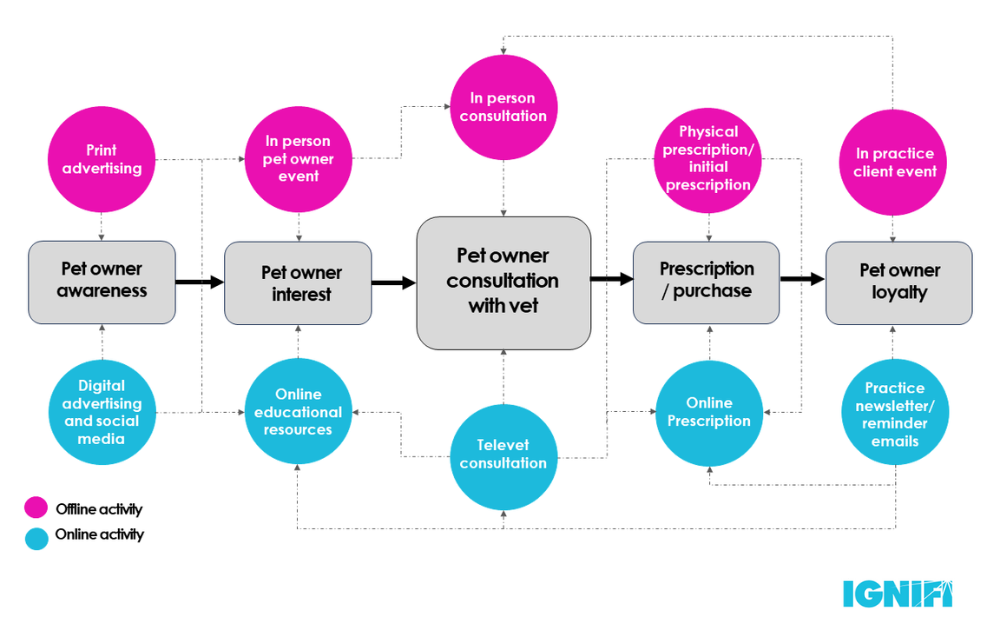
Since the Covid pandemic there has been a major change to the way healthcare is delivered, including animal healthcare. Online services, tools and telehealth have become the preferred choice for many pet owners.
Our latest blog delves into this transformation and explores how brands can effectively engage with vets and consumers in the era of virtual care.
Animal healthcare in 2024
The animal healthcare industry has embraced the digital era, offering pet owners access to a wide range of online tools. These tools not only provide impressive information and marketing techniques but also redefine the way pet owners learn about animal diseases and wellbeing. You can now easily order your beloved companion’s prescription medication online, adding to the convenience and accessibility of pet healthcare.
The latest online offering is the televet; a virtual vet, that can provide professional medical advice without the need for a practice visit. But what does having this in-depth, specialised knowledge at our fingertips mean for veterinary practices? And how can in-practice vets utilise these resources to re-establish and demonstrate their importance and value to pet owners?
As our trust in online services continues to rise, more consumers are discovering how doing things virtually can benefit them. Owners see their pets as an extension of their family, with increased consciousness about their health driving the popularity of the televet. Integrating professional veterinary advice with the convenience and accessibility of a virtual service, the televet offers a new way of managing health concerns for pet owners who may struggle to attend a traditional in-practice appointment. While the online vet doesn’t take away the need for in-person consultation (which remains the only way of obtaining the initial prescription for your pet), the service can certainly speed things up.
Alongside the recent push towards online services in animal healthcare, pet owners now also appear to take a more data-driven approach when it comes to looking after their pets. The rise in the popularity of animal healthcare trackers signifies the demand for better insights about the wellbeing of our pets, in the form of statistics and data. For animal healthcare marketers, the rise in digital awareness and drive for data at our fingertips is a key consideration when looking at how best to appeal to pet owners and offer innovative solutions.

The future of animal health
Since our last animal health update blog , televet services have continued to advance. The platform Video Vets Now, has further expanded its emergency appointment offering, with 24-hour referral hospitals in Glasgow and Manchester. In addition, the site runs a blog with a wide range of advice, how to guides, and pet symptom checkers1. These support materials can vastly improve customer experience, providing reassurance in high stress situations for pet owners.
The success of the televet is expected to continue alongside the growth of the global veterinary telehealth market2.
While vets may have showed mixed responses to the rise of the online vet, it is important to recognise that these platforms can also serve them with an opportunity to grow the success of their practice. A good example is Vidivet3. The platform acts as a triage service to members of subscribed practices:
• Owners have increased access options to care for their pet, including virtual appointments.
• Time saved by diverting less urgent appointments online leaves additional capacity in the practice for animals who need more serious care.
• 24/7 professional advice, offering convenience and peace of mind to pet owners.
• An opportunity for tracking of customer behaviour to further adapt and personalise experiences.
Of course, there is a cost involved for practices who choose to incorporate a televet service into their animal care. However, when used efficiently, the televet can offer a lot more than time-saving. For veterinary services who adopt a model such as Vidivet, reduced unnecessary visits to the practice (while owners receive appropriate support virtually) gives vets capacity to invest time and resources elsewhere. Whether this be taking on additional customers, supporting local animal shelters, or providing additional staff training to ensure excellent care, the televet can be used as a tool that enables veterinarians to give the best possible standard of care.
It is reasonable to expect that customers and vets may worry about the impact on the strength of their relationships if their practice decides to embrace a televet approach. One way that a practice may deal with this is by using appointment time saved to organise educational events for the community, such as behavioural training and sessions, understanding the symptoms of specific conditions or even how to ensure your pet is receiving the right nutrition. Maintaining and building on these relationships can lead to more opportunities for the practice, resulting in greater revenue and most importantly, higher customer satisfaction.

How can we embrace change in animal healthcare marketing strategy? Is there a place for omnichannel ?
Looking to the future, it’s clear that televet services are here to stay. Their potential and already proven applications in easing the pressure on veterinary practices and improving pet owner experiences demonstrate that the use of telehealth services is highly valuable.
With migration towards online services, vets may be conscious about losing the personal relationships built, worrying about pet owners feeling alienated. It is true that online tools cannot replicate face-to-face communication. But they can certainly get closer with the help of an omnichannel approach. This is where IGNIFI can help, by enhancing the connection between brands, vets and pet owners through personalised content, tailored to specific personas.
In 2018, nearly half of animal owner study respondents had never received website recommendations from their vet4. This signifies an opportunity for animal healthcare brands to connect with pet owners, providing tailored content from a source that they can trust. Having veterinary practices onboard with an omnichannel approach is key to success, therefore it needs to be clear that these resources can save vets’ time and provide better education to pet owners. Information doesn’t have to be dull; the personalisation of content should be engaging and make pet owners feel confident in the level of care that their animal receives. This means new and engaging disease awareness campaigns, the use of industry experts and even the odd prize up for grabs to encourage engagement.
While telemedicine has its benefits for some pet owners, in-practice appointments and discussions remain as important as ever. An omnichannel approach can deliver a customer journey that utilises the expertise of veterinary professionals, complemented by professionally approved online tools and resources. Offering a range of personalised content means that vets can provide information that is suited to individual pet owners, whether this be alongside the introduction of televet services or alone.
The capability of veterinary practices to execute a successful omnichannel approach will rely on animal healthcare brands acknowledging the need for these materials and providing a wide range of digital tools to support with pet owner education and engagement, highlighting the importance and value of expert veterinary advice and interaction with face-to-face check-ups.
To find out how IGNIFI can work with you on your animal health campaigns to support vets and pet owners with their online and offline interactions, please get in touch or find out more about or animal health experience here.








